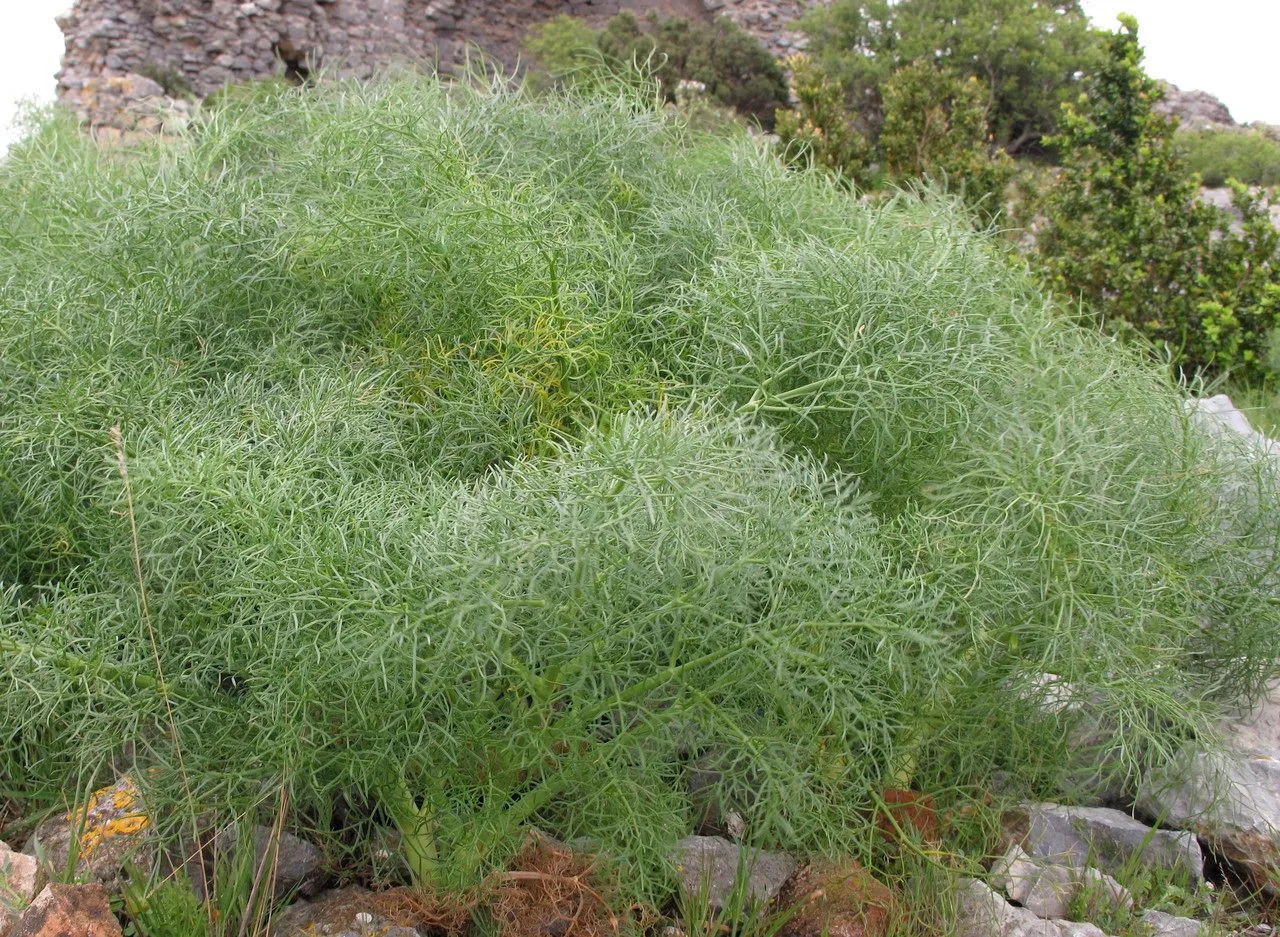
Author: L.
Bibliography: Sp. Pl.: 246 (1753)
Year: 1753
Status: accepted
Rank: species
Genus: Ferula
Vegetable: False
Observations: Medit. to Arabian Pen. and Tanzania
The Common giant-fennel, known scientifically as Ferula communis, stands as a remarkable species within the Apiaceae family. First documented by the eminent botanist Carl Linnaeus in his seminal work “Species Plantarum” published in 1753, this plant boasts a rich historical and botanical heritage.
Native to the regions spanning the Mediterranean, the Arabian Peninsula, and Tanzania, Ferula communis thrives in these diverse climates, showcasing a resilience to different environmental conditions. This perennial herb can grow up to an impressive height, making it a literal and figurative giant among the fennel family. The plant is characterized by its stout, hollows stems that support a crown of finely divided, feathery leaves, typical of many in the Apiaceae family.
The Common giant-fennel produces umbrella-like clusters of small yellow flowers, which bloom typically in the spring and early summer. These vibrant blossoms not only add a touch of color to the flora of its native regions but also play an important role in local ecosystems, attracting a variety of pollinators such as bees and other insects.
In historical and cultural contexts, Ferula communis holds a notable place. Its robust stems have been traditionally used in various practical applications, from livestock fodder to natural fencing materials in some Mediterranean cultures. Moreover, some parts of the plant have been historically used in traditional medicine, although modern research on its pharmacological properties is still ongoing.
The adaptability and robust nature of the Common giant-fennel also render it an intriguing subject for ecological and botanical studies. It stands as a testament to the incredible diversity and adaptability of plant life across a wide range of habitats and climates.
In summary, Ferula communis, or Common giant-fennel, is a plant that not only contributes to the biodiversity of the regions it inhabits but also carries a historical and practical significance. Its towering presence and yellow blooms make it a notable species within the Apiaceae family and a subject of interest for both historical and scientific exploration.
Eng: giant fennel, common giant-fennel, giant-fennel
Swe: jättestinkfloka
Ara: aboubal, besbas harami, fasoukh, kelkh
Spa: caña, caña del muermo, cañabeja
Ita: ferula comune
Cym: ffenigl mawr
Fra: férule commune, grande férule
En: Common giant-fennel, Giant-fennel, Giant Fennel, Feshook
Am: ዶግ
Ar: كلخ كبير, Aboubal, Besbas Harami, Fasoukh, Kelkh
Az: Adi ilankölgəsi
Ca: Canyaferla, Canyafèl·lera, Canyaferla comuna, Canyafèrlara, Fèrlara
Zh: 大阿魏
Fi: Välimerenkeltaputki
Fr: Férule Commune, Grande Férule, Pamelier, Ferule commune
De: Gemeines Rutenkraut, Gemeines Steckenkraut, Riesenfenchel, Knotenblühendes Steckenkraut
El: Νάρθηκας
He: כלך מצוי
It: Ferula comune, Finocchiaccio
Ky: Чайыр чөп же чаар куурай
Pt: Canafrecha
Es: Caña del muermo, Caña, Cañabeja, Cañaheja
Sv: Jättestinkfloka
Cy: Ffenigl mawr
Taken Feb 19, 2021 by Ja Cad (cc-by-sa)
Taken Jun 7, 2021 by Alain Bigou (cc-by-sa)
Taken Jan 14, 2021 by mairi maniopoulou (cc-by-sa)
Taken May 4, 2015 by kaktushorst (cc-by-sa)
Taken Feb 10, 2019 by Maria Hatzaki (cc-by-sa)
Taken Jan 18, 2021 by Esin Bozdogangil (cc-by-sa)
Taken Jun 7, 2021 by Alain Bigou (cc-by-sa)
Taken Apr 30, 2021 by Rocco Romeo (cc-by-sa)
Taken May 23, 2020 by Goose3 (cc-by-sa)
Taken Nov 23, 2021 by Medinka (cc-by-sa)
Taken Feb 16, 2020 by Albatroz (cc-by-sa)
Taken Jun 7, 2021 by Alain Bigou (cc-by-sa)
Taken Jun 7, 2021 by Alain Bigou (cc-by-sa)
Taken Jan 18, 2021 by Esin Bozdogangil (cc-by-sa)
Taken Jun 7, 2021 by Alain Bigou (cc-by-sa)
Taken Jun 7, 2021 by Alain Bigou (cc-by-sa)
Taken Jun 7, 2021 by Alain Bigou (cc-by-sa)
Taken Mar 31, 2018 by Szabolcs Frater (cc-by-sa)
Taken Apr 25, 2011 by Tela Botanica − Marie PORTAS (cc-by-sa)
Taken Jun 7, 2021 by Alain Bigou (cc-by-sa)
Taken Nov 4, 2012 by Tela Botanica − Yoan MARTIN (cc-by-sa)
Taken Mar 2, 2012 by Tela Botanica − Yoan MARTIN (cc-by-sa)
Taken Dec 20, 2019 by Adil Adil (cc-by-sa)
Taken Feb 16, 2022 by Concha Tormo (cc-by-sa)
Taken Jan 18, 2021 by Esin Bozdogangil (cc-by-sa)
Taken May 20, 2014 by Tela Botanica − Marie-France PETIBON (cc-by-sa)
Taken Oct 25, 2022 by Uli Zenner (cc-by-sa)
Taken Oct 25, 2022 by Uli Zenner (cc-by-sa)
Taken Mar 2, 2012 by Tela Botanica − Yoan MARTIN (cc-by-sa)
Taken Mar 2, 2012 by Tela Botanica − Yoan MARTIN (cc-by-sa)
© copyright of the Board of Trustees of the Royal Botanic Gardens, Kew.
© copyright of the Board of Trustees of the Royal Botanic Gardens, Kew.
© copyright of the Board of Trustees of the Royal Botanic Gardens, Kew.
Ph maximum: 8.0
Ph minimum: 7.5
Light: 7
Atmospheric humidity: 4
Soil nutriments: 8
Family: Myrtaceae Author: (F.Muell.) K.D.Hill & L.A.S.Johnson Bibliography: Telopea 6: 402 (1995) Year: 1995 Status:…
Family: Rubiaceae Author: Pierre ex A.Froehner Bibliography: Notizbl. Bot. Gart. Berlin-Dahlem 1: 237 (1897) Year:…
Family: Sapindaceae Author: Koidz. Bibliography: J. Coll. Sci. Imp. Univ. Tokyo 32(1): 38 (1911) Year:…
Family: Asteraceae Author: A.Gray Bibliography: Pacif. Railr. Rep.: 107 (1857) Year: 1857 Status: accepted Rank:…
Family: Fabaceae Author: Medik. Bibliography: Vorles. Churpfälz. Phys.-Ökon. Ges. 2: 398 (1787) Year: 1787 Status:…
Family: Aspleniaceae Author: (Cav.) Alston Bibliography: Bull. Misc. Inform. Kew 1932: 309 (1932) Year: 1932…